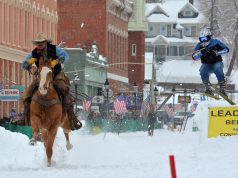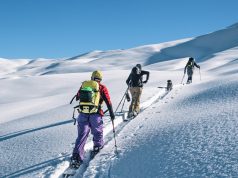It would drive most people insane. During the late 1930s Albert Curnow spent three years working as a fire lookout on the edge of Oregon’s Siskiyou Mountains. One summer he didn’t see another person.
Curnow’s lonely existence, on the fringes of civilization, is the stuff that dreams — or nightmares — are made of. It was an existence born from the terrible flames of summer — a vain attempt by humans to stop the fires that sweep through the West every year, denuding mountainsides and turning the sunsets red as blood.
Last summer, with air hazy from smoke, we decided that we wanted to taste a bit of the heat. We thought we’d like to see the flames from afar, like Curnow, and maybe even a bit closer as well. Not when things were really hot, mind you. But after the trees were turned into black sticks and the air was still metallic with smoke.
We headed west, because the West was on fire. During the first years of America’s western migration, fire remained unchecked. Early blazes ravaged the landscape. One, in Oregon, burned 8,000 acres, an area larger than Rhode Island. But as civilization spread, so, too, did the impetus to control forest fires.
In 1886, the U.S. Army was assigned to control fires in Yellowstone National Park. The responsibility for wildfires was passed on to the U.S. Forest Service in 1905. Five years later the West would burn all through a long, hot summer.
The USFS, stretched thin, could only watch as the flames consumed the landscape. When winter finally killed the last embers, 78 firefighters were dead. In the smoldering aftermath, the USFS gained funding and attention. One way the money was spent was to build a network of lookouts that were staffed by folks like Curnow. Individuals who could handle the isolation and endless monotony of days with nothing to do but look for the wisp of smoke that signaled wildfire. In the 1930s thousands of lookouts were built, but today less than 1,000 remain.
We ended up at one of them, Drake Peak, Ore., close to where Curnow basked in solitude. Drake Peak is a lonely, windswept place. Hidden outside the small town of Lakeview, Drake looks out on mountains that dissolve into the desert of eastern Oregon. To the south, you can see deep into California.
This morning, high on Drake Peak, the sun comes early.
Stiff from mountain biking on a remote trail called No. 161 near the California border, we stretch our legs as the lookout warms in the early
light.
Trail 161
has crushed us. Winding across the plateau below Drake, it’s rugged and
hard to follow, a remote gem that is perfect for mountain bikers and
adventurous hikers. It’s left us dirty and sore. As we pack our gear for
another day of riding, the hint of woodsmoke drifts in on the morning
breeze. Oregon is burning.
Two weeks later we’ve left the high peaks and deserts of
southeast Oregon and are eating New Mexican dust.
The trail kills us. A slick
combination of roots, dust, rocks and polished rock, it climbs up a
ridge darkened with the burned sticks of pines. We sweat and suck at our
water bottles as we contemplate the ravished landscape. It’s a
wasteland, the beauty of which only becomes apparent when we reach the
top.
There, as a
cool breeze washes across the landscape and the setting sun casts long
shadows through blackened stumps, the ridge glows, haunting and strange,
in the evening light, causing us to catch our breath in amazement.
The views are the
result of fires that torched the landscape surrounding the small
mountain town of Los Alamos, N.M. Started by an ill-conceived preventive
burn courtesy of the USFS in 2000, the conflagration swept out of
control through the Jemez Mountains, making national headlines as the
flames threatened the birthplace of the atom bomb, the Los Alamos
National Laboratory, forcing local residents to scramble for safety.
The fire’s logic was
random and harsh. Houses burned, but others next to them remained
standing. The local ski area, Pajarito, was untouched, while surrounding
ridges succumbed to the inferno. The scars are still visible, although
the memories of those hectic days — when residents ran for their lives,
unsure if they would ever return — have faded.
It will take longer,
though, for the scars to fade in Colorado’s South Platte Basin. One of
the most notorious fires in the scorched history of the West, the Hayman
fire, tore through 137,000 acres in 2002.
The largest fire in Colorado history, the
Hayman fire cost more than $1 billion to fight and destroyed more than
130 homes. The devastation might have been easier to swallow had the
flames been an act of God, but it was a Forest Service employee, Terry
Barton, who made headlines for starting the blaze.
From the vantage of the
Colorado Trail, which traverses parts of Jefferson and Douglas counties,
the areas hardest hit by the fire, the damage is obvious, although time
and Mother Nature are conspiring to heal the landscape. Less obvious is
the human cost, the old cabins where families gathered each summer,
gone. The Hayman destroyed lives, including Barton’s, who ended up in
prison for her role in starting the blaze.
Still, these parts of the Colorado Trail are a
joy to ride. The Lost Creek “detour” avoids wilderness areas, via dirt
and unimproved roads. It’s fast riding, with good climbs and a couple of
stream crossings. We pause at one, soaking our feet in the cool water,
and feel the burn in our legs from a ride that’s only just started.
Respond: [email protected]
Details,
details
Oregon
Drake Peak Lookout
and Trail 161: Lakeview Ranger District —
541-947-3334
New
Mexico:
Los
Alamos: pajaritoeec.org/guides/trails.php
Colorado:
The Colorado Trail: coloradotrail.org














